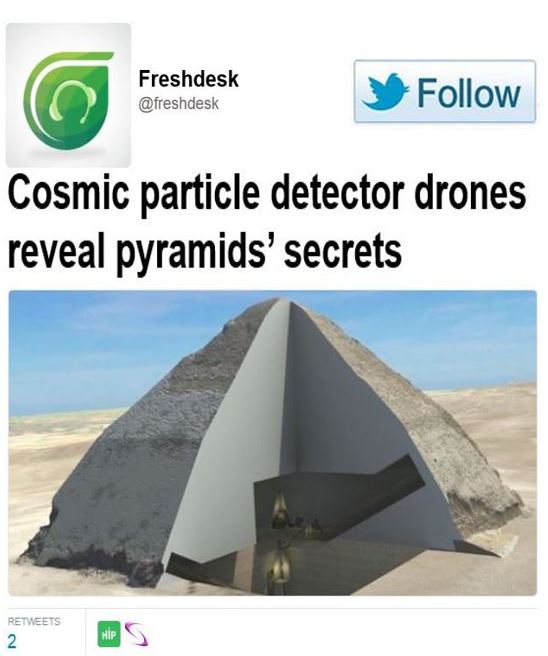We can now peek inside the Egyptian pyramids using cosmic rays, say scientists who were amazed at what they have observed so far. This state-of-the-art technology allows physicists to plot 3-dimensional maps of the interior of the pyramids, thus creating virtual-reality-like experience.
An international team of scientists from France, Japan and Egypt are using a specially-created film to record the path of muons – radiographic particles that continuously rain down onto us from the Earth’s atmosphere. They were created from collisions between cosmic rays in the Universe and the nuclei of atoms in our atmosphere.
A muon, also called a mu meson, is a collective name for two semi-stable fundamental particles with negative and positive charge. A muon’s mass is 207 times greater than that of an electron. Right now, more than 1,000 muons are passing through each one of us.
 Scientists believe they now have the technology to reveal the long-hidden secrets of the Egyptian pyramids – how many chambers and passageways are inside them, who was buried there, and why they were built. (Image: twitter.com/freshdesk)
Scientists believe they now have the technology to reveal the long-hidden secrets of the Egyptian pyramids – how many chambers and passageways are inside them, who was buried there, and why they were built. (Image: twitter.com/freshdesk)
Muon features used to create 3-D image
The muons pass through empty spaces, but are deflected or absorbed by hard surfaces. Scientists use this feature to recreate a 3-D image of the pyramid’s shape and hollow spaces inside by placing the special film in one of the chambers.
This project – finding out about the inside of pyramids using cosmic rays – is called ScanPyramids, and has so far been used on the 4,600-year-old Bent Pyramid, located at the royal necropolis of Dahshur, about 40 kilometres (25 miles) south of Cairo.
Scanpyramids.org quotes Hany Helal, a Professor at Cairo University and former Minister of Research and the higher education and Coordinator of the project, head of mission for the Faculty of Engineering of Cairo, who said:
“Many theories have been proposed, either explaining their construction or their structural anomalies, but we are physicists and engineers, not archaeologists. Our goal is to use techniques to get concrete results. Then the Egyptologists will interpret them.”
Interesting! Using cosmic rays (muons, to be specific) to scan Egypt’s pyramids.. https://t.co/fN4k05SBXV @HIP_i_
— Richard Selwyn Jones (@selwynox) 5 May 2016
So far, the ScanPyramids scientists have managed to rule out the possibility that the pharaoh who built the pyramid – Sneferu, the founder of the 4th dynasty during the Old Kingdom – was buried within the building.
According to Mehdi Tayoubi, president and co-founder of the Heritage Innovation Preservation Institute, who is also a co-director of the ScanPyramids project, over ten million muon tracks have been analyzed so far from the plates that were placed within a chamber in the Bent Pyramid.
In an interview with Discovery.com, Dr. Tayoubi said:
“For the first time ever, the internal structure of a pyramid was revealed with muon particles. The images obtained clearly show the second chamber of the pyramid located roughly 60 feet above the lower one in which emulsions plates were installed.”
Vice-President of the Heritage Innovation Preservation Institute (the Institute), Hany Helal, explained that the aim of the project is to either confirm, upgrade, change or modify the dozens of theories and hypotheses that currently exist regarding the construction of the Egyptian pyramids, why they were built, and what or who is inside them.
![]() According to scanpyramids.org: “Detectors, placed at appropriate places (e.g. inside the pyramid, under a possible yet undetected chamber) allow, by accumulation of muons over time, to discern the void areas (that muons crossed without problem) from denser areas where some of them were absorbed or deflected.” (Image: scanpyramids.org)
According to scanpyramids.org: “Detectors, placed at appropriate places (e.g. inside the pyramid, under a possible yet undetected chamber) allow, by accumulation of muons over time, to discern the void areas (that muons crossed without problem) from denser areas where some of them were absorbed or deflected.” (Image: scanpyramids.org)
Pyramid experts may disagree on many things, but they all definitely agree on one: there is not one single theory or hypothesis that is 100% checked or proven.
The physicists will use the same technology on two pyramids in Dashur and two others in Giza.
With the help of two infrared and laser scans, as well as the muon-tracking technology, the scientists hope they will eventually find the hidden tomb of Queen Neferneferuaten Nefertiti within Tutankhamen’s burial chamber.
Nefertiti (ca. 1370-1330 BC) was an Egyptian queen and the Chief Consort (Great Royal Wife) of the pharaoh Akhenaten. Akhenaten and Nefertiti were extremely religious and worshiped just one god – Aten, or the sun disc.
Dr. Tayoubi said:
“Even if we find one square meter void somewhere, it will bring new questions and hypotheses and maybe it will help solve the definitive questions.”
